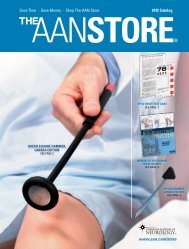Practice parameter: Evaluating a first nonfebrile seizure in children
Practice parameter: Evaluating a first nonfebrile seizure in children
Practice parameter: Evaluating a first nonfebrile seizure in children
Create successful ePaper yourself
Turn your PDF publications into a flip-book with our unique Google optimized e-Paper software.
zure patients. 40,41 In these studies, <strong>in</strong>terpretation<br />
was difficult <strong>in</strong> the presence of diffuse postictal slow<strong>in</strong>g,<br />
42 and an EEG done at that time was not helpful<br />
<strong>in</strong> determ<strong>in</strong><strong>in</strong>g which patients should be admitted to<br />
the hospital. 40<br />
A recent analysis of selected f<strong>in</strong>d<strong>in</strong>gs from several<br />
of the Class I studies referred to above 25-27,30,31 concluded<br />
that an EEG should not be rout<strong>in</strong>ely performed<br />
after a <strong>first</strong> <strong>seizure</strong> because it does not yield<br />
sufficient <strong>in</strong>formation to alter treatment decisions. 43<br />
To reach this conclusion, the authors did not consider<br />
evidence that the EEG result does <strong>in</strong> fact alter<br />
treatment decisions. They assumed a treatment<br />
threshold to be at an 80% risk of recurrence, and<br />
used a univariate analysis. However, where the EEG<br />
is used as one of several variables, it can identify<br />
<strong>children</strong> with very high and very low recurrence<br />
risks. 25,26,32,35 The EEG is not used solely to determ<strong>in</strong>e<br />
recurrence, but also helps differentiate a <strong>seizure</strong><br />
from other events, is essential to the diagnosis of a<br />
syndrome, and provides <strong>in</strong>formation on long-term<br />
prognosis; it <strong>in</strong>fluences the decision to perform subsequent<br />
neuroimag<strong>in</strong>g studies 44 and may <strong>in</strong>fluence<br />
counsel<strong>in</strong>g about management of the child.<br />
Conclusions. The majority of evidence from Class<br />
I and Class II studies confirms that an EEG helps <strong>in</strong><br />
determ<strong>in</strong>ation of <strong>seizure</strong> type, epilepsy syndrome,<br />
and risk for recurrence, and therefore may affect<br />
further management decisions. Experts commonly<br />
recommend that an EEG be performed after all <strong>first</strong><br />
<strong>nonfebrile</strong> <strong>seizure</strong>s. 39,45-47 It is not clear what the optimal<br />
tim<strong>in</strong>g should be for obta<strong>in</strong><strong>in</strong>g an EEG. Although<br />
an EEG done with<strong>in</strong> 24 hours of the <strong>seizure</strong><br />
is most likely to show abnormalities, 34 physicians<br />
should be aware that some abnormalities such as<br />
postictal slow<strong>in</strong>g that can be seen on EEG done<br />
with<strong>in</strong> 24 to 48 hours of a <strong>seizure</strong> may be transient<br />
and must be <strong>in</strong>terpreted with caution.<br />
There is no evidence that the EEG must be done<br />
before discharge from the emergency department;<br />
the study may be arranged on an outpatient basis.<br />
Epileptiform EEG abnormalities may be useful <strong>in</strong><br />
confirm<strong>in</strong>g that the event was a <strong>seizure</strong>; however, an<br />
EEG abnormality by itself is not sufficient to make a<br />
diagnosis that an epileptic <strong>seizure</strong> occurred, nor can<br />
its absence rule out a <strong>seizure</strong>. 46,47 The EEG is necessary<br />
to determ<strong>in</strong>e the epilepsy syndrome and the<br />
diagnosis of an epilepsy syndrome may be helpful <strong>in</strong><br />
determ<strong>in</strong><strong>in</strong>g the need for imag<strong>in</strong>g studies. 34 The EEG<br />
is also useful <strong>in</strong> predict<strong>in</strong>g the prognosis for<br />
recurrences. 20,39,45-47<br />
It is not clear what the optimal tim<strong>in</strong>g should be<br />
for obta<strong>in</strong><strong>in</strong>g an EEG. Although an EEG done with<strong>in</strong><br />
24 hours of the <strong>seizure</strong> is most likely to show abnormalities,<br />
physicians should be aware that some abnormalities<br />
such as postictal slow<strong>in</strong>g that can be<br />
seen on EEG done with<strong>in</strong> 24 to 48 hours of a <strong>seizure</strong><br />
may be transient and must be <strong>in</strong>terpreted with<br />
caution.<br />
Recommendations.<br />
• The EEG is recommended as part of the neurodiagnostic<br />
evaluation of the child with an apparent<br />
<strong>first</strong> unprovoked <strong>seizure</strong>. (Standard)<br />
Neuroimag<strong>in</strong>g studies. Evidence—CT scans.<br />
There were five Class I studies regard<strong>in</strong>g imag<strong>in</strong>g by<br />
CT scan after a <strong>first</strong> <strong>seizure</strong>; the data perta<strong>in</strong>ed to<br />
<strong>children</strong> 32 and adults 24,42,48 with <strong>first</strong> <strong>seizure</strong>s, and to<br />
adults and <strong>children</strong> over age 6 with both new onset<br />
and established <strong>seizure</strong>s. 14 In the s<strong>in</strong>gle Class I<br />
study of <strong>first</strong> <strong>seizure</strong>s <strong>in</strong> <strong>children</strong>, the abnormalities<br />
(mostly atrophy) found <strong>in</strong> 12 <strong>children</strong> were “without<br />
therapeutic consequences” (95% CI 0, 3%). 32 In one of<br />
the adult studies, 1.3% of the patients who had CT<br />
scans were diagnosed with tumors, 24 and <strong>in</strong> another,<br />
of 62 patients there were three tumors seen on CT,<br />
all <strong>in</strong> patients with abnormal neurologic exam<strong>in</strong>ations.<br />
42 Of 119 adults who had CT scans after a <strong>first</strong><br />
generalized <strong>seizure</strong>, 20 had abnormalities that warranted<br />
therapeutic <strong>in</strong>tervention. 48 In the Class I<br />
study <strong>in</strong> which 19 CT scans were done <strong>in</strong> selective<br />
cases (<strong>first</strong> <strong>seizure</strong>s if greater than age 6 years, head<br />
trauma, or focal <strong>seizure</strong>), there was one significant<br />
abnormality (age of the patient was not given), a<br />
subdural hematoma, not predicted by history and<br />
physical exam<strong>in</strong>ation. 14<br />
Of the 14 Class II studies, n<strong>in</strong>e <strong>in</strong>volved <strong>children</strong><br />
only (n � 2559), 17,19,49-56 four were of adults only (n �<br />
666), 24,42,57,58 and one <strong>in</strong>volved <strong>children</strong> and adults<br />
(n � 109). 59 Only a small percentage of <strong>children</strong> <strong>in</strong><br />
these studies (0 to 7%) had lesions on CT that altered<br />
or <strong>in</strong>fluenced management. These were most<br />
commonly bra<strong>in</strong> tumors, communicat<strong>in</strong>g or obstructive<br />
hydrocephalus, one subarachnoid and one porencephalic<br />
cyst, and three <strong>children</strong> with cysticercosis.<br />
The yield of abnormality on CT when the neurologic<br />
exam<strong>in</strong>ation and EEG were normal was 5 to 10%. 50,54<br />
In a Class II study <strong>in</strong> which seven <strong>children</strong> (14% of<br />
<strong>children</strong> with <strong>nonfebrile</strong> <strong>seizure</strong>s) had CT scans that<br />
<strong>in</strong>fluenced management, five had focal or complex<br />
partial <strong>seizure</strong>s. Abnormalities on neuroimag<strong>in</strong>g<br />
were associated with a higher recurrence risk. 54 In<br />
one study of febrile and <strong>nonfebrile</strong> <strong>children</strong>, CT<br />
scans were always normal <strong>in</strong> the absence of def<strong>in</strong>ed<br />
risk factors such as known neurologic diagnosis,<br />
age �5 months, or focal deficit. 57 Focal lesions on<br />
CT scans tended to be more commonly found <strong>in</strong><br />
adults (18 to 34%) 40,48,57,58 than <strong>in</strong> <strong>children</strong> (0 to<br />
12%), 17,32,49,52,54-56 particularly when ordered for specific<br />
cl<strong>in</strong>ical <strong>in</strong>dications. At least three studies provided<br />
evidence that MRI scann<strong>in</strong>g was preferable to<br />
CT 51,54,60 <strong>in</strong> <strong>children</strong> follow<strong>in</strong>g <strong>nonfebrile</strong> <strong>seizure</strong>s.<br />
Evidence—MRI. There was one Class I report regard<strong>in</strong>g<br />
MRI <strong>in</strong> <strong>children</strong> present<strong>in</strong>g with a <strong>first</strong> <strong>seizure</strong><br />
54 and another Class I report of newly diagnosed<br />
epilepsy <strong>in</strong> <strong>children</strong>. 60 Of 411 <strong>children</strong> who presented<br />
with a <strong>first</strong> <strong>seizure</strong>, 218 had neuroimag<strong>in</strong>g studies.<br />
Four had lesions seen on MRI or CT (two bra<strong>in</strong> tumors,<br />
two neurocysticercosis) that potentially altered<br />
September (1 of 2) 2000 NEUROLOGY 55 619



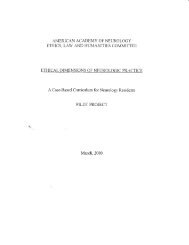

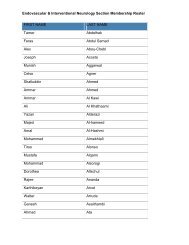
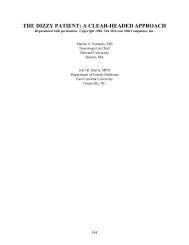

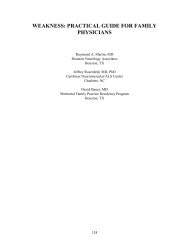
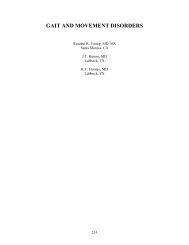
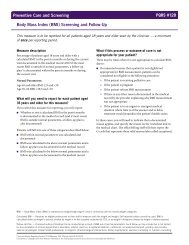
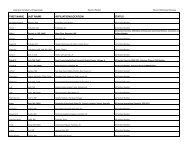
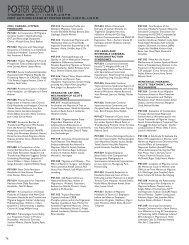
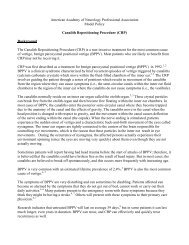
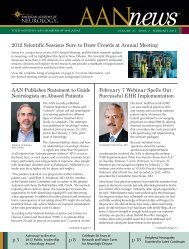
![[Click here and type date] - American Academy of Neurology](https://img.yumpu.com/8582972/1/190x245/click-here-and-type-date-american-academy-of-neurology.jpg?quality=85)
